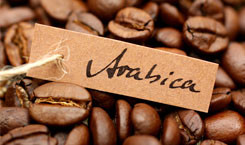Arabica Beans
Arabica is the well-known superstar amongst the coffee varieties. Originating from the coffee arabica plant, the arabica beans are mostly known for the finest aromas and qualities and make up for about three quarters of the worlds coffee production.
What do arabica beans look like?
 In heights of 800 up to 2100 meters above sea level, arabica plants, sometimes called „mountain-coffee“ prosper from fresh, humid and balanced climate conditions. 17 °C to 25 °C are ideal for arabica plants. The, when left to grow, sometimes six meters tall plants produce prominent, red berries. When separated from their flesh, roasted and dried, arabica beans are of vividly brown color and longish shape with a curved, s-shaped slot in its middle.
In heights of 800 up to 2100 meters above sea level, arabica plants, sometimes called „mountain-coffee“ prosper from fresh, humid and balanced climate conditions. 17 °C to 25 °C are ideal for arabica plants. The, when left to grow, sometimes six meters tall plants produce prominent, red berries. When separated from their flesh, roasted and dried, arabica beans are of vividly brown color and longish shape with a curved, s-shaped slot in its middle.
What do arabica beans taste like?
A good batch of arabica beans taste like its environment, fresh mountain air. Arabica beans convince with with their clear, balanced and slightly fruity-sweetish aroma. Their strong fragrance and the brownish-red cream make arabica coffee beans the most classical bean variety used for the European espresso culture. Mild notes combined with low amounts of Chlorogen acids and low to medium caffeine content make arabica to a comparably digestibly harmonic coffee compatible with even the most sensible of coffee lovers.
Not everything that shines is gold
Although, most of the arabicas properties are considered noble, the popular label „100% Arabica“ doesn’t necessarily warrant the products superior quality. Actually, only five percent of the world coffee production are officially classed as „superior quality“ and just like in the world of wine, there is bad products with good brand names as there is the other way around. It is advisable to not just blindly follow all the brand names that are somehow connected to good coffee. For example the popular description „Brazil Santos“ cannot warrant quality or superior aroma because Santos is nothing more than Brazils largest cargo harbor and port of disembarking for a major part of the Brazilian coffee. Although, arabica beans are usually being classes higher than robusta beans, there is top-quality robusta batches and terrible arabica batches. If you are looking for a good and tasty arabica blend, you should therefor consider quality and proportions of the different varieties within the bland rather than name and brand. And the only way to determine, which quality and variety you like best, is to try!
Probieren geht über studieren
Since coffee is one of the most diverse drinks ever invented and because there are just as many tastes, preferences and opinions as there are qualities, aromas and varieties, it often pays off, to give a go what you think might be what is best for you. Give a pure Artabica-blend, an exotic 100% Robusta-blend or some of our finest and Finley-balanced blends a go to look for your personal favorite.

